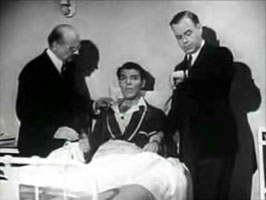 Michael Loring stars in I Need a Nurse (1941), singing the title song from his bed, flanked by two doctors: "You all agreed a rest cure/ Would surely be the best cure/ For my heart condition/ Now after months of resting/ And metabolism testing/ I'm no better by your own admission...." Michael Loring stars in I Need a Nurse (1941), singing the title song from his bed, flanked by two doctors: "You all agreed a rest cure/ Would surely be the best cure/ For my heart condition/ Now after months of resting/ And metabolism testing/ I'm no better by your own admission...."
Hard to imagine a worse song, & no less disrespectful of the profession of nursing than a "nurse porn" film would be. Though it lacks a "patriotic" bent such as were a commonplace among wartime soundies, it doubtless found its way into the Panoram jukeboxes because of the popularity of the visual jukeboxes with soldiers, & the number of soldiers coming home wounded. It turned tragedy into romantic comedy.
The humor of being injured or sick just isn't captured in novelty-tune lyrics that assume if he had a nurse ("a cute little baby who marks my chart/ To upset my applecart"), instead of balding doctors, he just might get well.
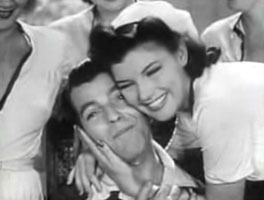 He leaps up from bed, spry as you please, right into a wheelchair. One of the doctors pushing him through the French doors into a day room. Five nurses gather round him, flirting, hugging, showing no professional disposition toward nursing, so perhaps it isn't really a hospital but a bordello in which everyone is just playing hospital. He leaps up from bed, spry as you please, right into a wheelchair. One of the doctors pushing him through the French doors into a day room. Five nurses gather round him, flirting, hugging, showing no professional disposition toward nursing, so perhaps it isn't really a hospital but a bordello in which everyone is just playing hospital.
Additional nurses come dancing through, then some of the girls actually get spoken-song lines like "You need some love not a nurse/ Puicker up let's reherse." And our lead vocalist's last sustained line is "And I never felt so well!"
Loring was a minor film & musical stage actor of the 1930s, whose career was already in the dumpster when he settled for a few days' work making soundies. He made eight, all in 1941, all backed on the soundtrack by the unseen soundies house band of that year, Ray Bloch & His Orchestra.
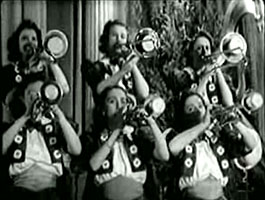 Dave Schooler & His Twenty-One Swinghearts star in the three-minute soundie Sheherezade (1941) performing the Rimsky-Korsavoff piece so titled.
Dave Schooler & His Twenty-One Swinghearts star in the three-minute soundie Sheherezade (1941) performing the Rimsky-Korsavoff piece so titled.
The all-girl orchestra seems to be quite young & all the girls are pretty. They seem not to have had a performance career outside of soundies, so may have been dashed together by the "classical" director of the soundies production lines, Fredrik Feher, or such is my guess.
The name Swinghearts is perhaps too obvious a pun, so not the first time it was used. There had formerly been an all-girl brass ensemble called the Swinghearts led by Phil Spitainy, & a small USO girl band, Eleanor Sherry & the Swinghearts. But the soundies' Swinghearts seem almost to be kids.
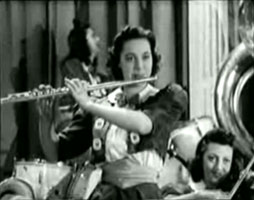 The band's leader, Dave Schooler, was noted for glamorous stage productions & musicals, & did USO shows during the war, so perhaps the all girl orchestra was part of some obscure USO troupe entertaining soldiers. The band's leader, Dave Schooler, was noted for glamorous stage productions & musicals, & did USO shows during the war, so perhaps the all girl orchestra was part of some obscure USO troupe entertaining soldiers.
The attempt to render classical tunes like "Sheherezade" into swing arrangements is only about half effective. The arrangement is very busy in order to give each part of the band a highlight moment, & solos for flute, violin, & clarinet.
It doesn't come off entirely professional as do such all-girl orchestras as those of Thelma White & Ina Ray Hutton or the International Sweethearts of Rhythm.
It just barely scoots by on the novelty of being all girls, but kind of discouraging they're not more impressive as musicians per se.
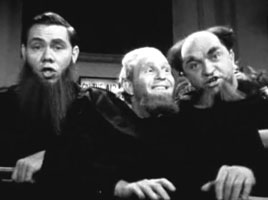 The idea of a women's orchestra called the Swinghearts was duplicated in another soundie which seems to have no connection to the earlier Swinghearts soundie, as the girls are suddenly much more mature & pretty obviously chorus gals, perhaps even the same as the so-called "Glamourettes" who appear in a couple of soundies & as an all-girl band in one of those.
The idea of a women's orchestra called the Swinghearts was duplicated in another soundie which seems to have no connection to the earlier Swinghearts soundie, as the girls are suddenly much more mature & pretty obviously chorus gals, perhaps even the same as the so-called "Glamourettes" who appear in a couple of soundies & as an all-girl band in one of those.
Practically a miniature musical comedy, Crazy Quizz (1942) spoofs radio games shows of the time. It features singer Bob Hughes, a singing chorus of girls called the Swinghearts, & three gents in absurd judge costumes billed as the Three Hollywood Judges as though they were a real act.
Hughs sings "questions" or riddles, the girls one by one answer the riddles in lyrics, then the judges repeat the answers.
They're supposed to be jokes that rhyme, & they might strike a few funnybones, though not mine. Typical is Hughes sings to a "contestant": "Should a gentleman strike a lady, can you answer that." Beautiful contestant answers, "A gentleman should not sock a lady unless he removes his hat." The three judges repeat the contestant's line.
It leads to the three judges dancing foolishly, the chorus girls join in, Bob plays with his microphone & roles hlis eyes. Though it's a very visual soundie, reliant on the beauty of the girls & the silly appearance of the judges, yet it pretends to be a radio performance & we even once glimpse the control room for the radio show.
The pre-recorded music was provided by Lud Gluskin & His Orchestra, adequate to the task. I presume "The Swinghearts" like the Three Hollywood Judges were not a real act beyond this soundie. Even Bob Hughes, who appears in two soundies, seems only to have been a failed actor.
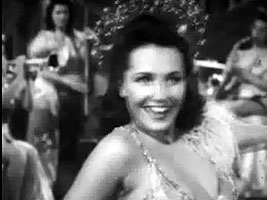 The chorus girls billed as "The Glamourettes" are alleged in the title card to be "America's Most Gorgeous Girl Band," for the soundie Swing It, Mr. Schubert (1944). It seems likely they're just miming some uncredited band's pre-recording, since in other soundies they are merely dancers & not very good even at that.
The chorus girls billed as "The Glamourettes" are alleged in the title card to be "America's Most Gorgeous Girl Band," for the soundie Swing It, Mr. Schubert (1944). It seems likely they're just miming some uncredited band's pre-recording, since in other soundies they are merely dancers & not very good even at that.
If I've perceived wrongly then shame on me for underestimated these gals, but the Glamourettes seem to be a conoction of the soundies production staff.
As for Carol Adams nee Lurline Uller, she has screen charisma & makes this soundie worthwhile. She was a minor actress in very few B movies, reaching her height of semi-success in 1941, the year she was seen tapdancing in Gene Autry's Ridin' on a Rainbow (1941), & was Roy Rogers' love interest in Bad Man of Deadwood (1941), resulting in very slight but lasting notice among vintage western fans.
She'd started out as a child actress along with Mickey Rooney in Our Gang Comedy silent films. As a teenager she was on the vaudeville circuit, & from age eighteen to twenty had a Twentieth Century Fox contract that took her nowhere, followed by a Republic Pictures contract which lapsed in only one year.
She was occasionally acknowledged as one of the leading female tappers of the 1940s but this tended to gain her mostly uncredited roles in a passing dance sequences in movies of small merit, or a featured dance moment outside the chorus line of stage revues. Because Shirley Temple was actually a piss-poor tapdancer, Carol sometimes dubbed Shirley's tapping, a bittersweet claim to fame.
By 1944, as a film starlet, she was reduced to roles in a trio of soundies. She no longer had a studio contract & her career was essentially over. The soundies were her last hurrah, & she would soon after vanish into the duties of a housewife & mother, which I'm sure was more rewarding.
Carol dances in front of the girl band she's conducting. We're shown various musicians playing solos or in groups, then always back to Carol dance-conducting. The two pianists behind her are playing a "double" piano with keys on both sides.
The instrumental attempts to be Benny Goodman type swing blending with Schubert isn't that effective, & the point is obviously the prettiness of the girls. And the highlight is indeed Carol dancing. She can be seen dancing to a vastly better tune in Juke Box Joes (1944) & even singing in Dancing the Hot Foot (1942).
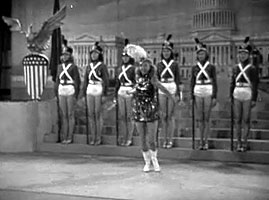 The dance troupe called the Glamourettes appear along with the Ziegfeld Follies' acrobatic dance stars the Keene Twins in Liberty on Parade (1943), a miserable little patriotic soundie.
The dance troupe called the Glamourettes appear along with the Ziegfeld Follies' acrobatic dance stars the Keene Twins in Liberty on Parade (1943), a miserable little patriotic soundie.
At no time do the twins seem very important to the awful choreography. There's a moment when we see the Keenes posing with trumpets, & that's all. This hardly seemed worthy of special credit on the introductory text cards, but perhaps they had a lot of press that year so that even a flash-by became commercially worthy of underscoring.
We also see a split second a woman named Arville Clair dressed up (I'm guessing) as Miss Liberty. I can only guess she was a beauty queen from somewhere or another, who became flavor of the month, then left small record of having passed our way.
Many soundies with good music were gussied up with beautiful models & chorus girls, but this one has only the girls to recommend it.
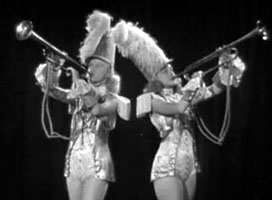 After an introductory scene of warplanes, to a generic military marching tune, the Glamourettes stride long-legged down a staircase in costumes half showgirl & half airforce uniform, doing high kicks then lining up for some enfeebled French can-can kicks. After an introductory scene of warplanes, to a generic military marching tune, the Glamourettes stride long-legged down a staircase in costumes half showgirl & half airforce uniform, doing high kicks then lining up for some enfeebled French can-can kicks.
Jump-cut to ships at sea with warplanes overhead. Cut again to close up of another close-up of a babe. Momentarily, girls in navy-like chorus girl outfits come down the steps to march in place then do a bit of swabbies' dance together.
More costume changes represent various branches of the military in an alternate world where soldiers & sailors are chorus girls. There's even a classic baton-twirler routine, pretty much all of it lousy stuff, with the nation's capital depicted on the backdrop curtain.
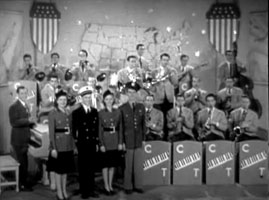 While on the subject of patriotic soundies, they were never the best the soundies had to offer, but it was wartime after all, & soundies producers, just like Hollywood, were asked to produce films to uplift moral for soldiers & civilians. The military sometimes even provided underwriting funds for such films.
While on the subject of patriotic soundies, they were never the best the soundies had to offer, but it was wartime after all, & soundies producers, just like Hollywood, were asked to produce films to uplift moral for soldiers & civilians. The military sometimes even provided underwriting funds for such films.
A vocal quartet consisting of Lillian Lane, Martha Wayne, Buddy Stewart, & Dick Harding are featured in America, I Love You (1942). This is a rare case of each singer in a group getting individual credit on one three opening title & credits, credits having always been skimpy on soundies. Buddy & Martha are standing in the middle, Buddy's military hat looking rather large on his teency noggin.
Lillian Lane soon after the war sang for Gene Krupa, & is the vocalist on the 1948 hit "I Wanna Be Loved" by the Benny Goodman orchestra under Tex Beneke. Martha Wayne & Buddy Stewart were married & had formerly performed as a duo. They put together the vocal group "The Snowflakes" (not so credited in the soundie for some reason) which sang for both the Claude Thornhill Orchestra & the Glenn Miller Band.
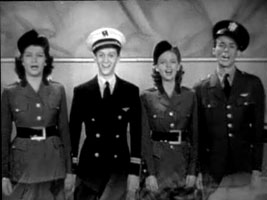 In the post war period Buddy sang bebop with the Gene Krupa band & the Charlie Barnet's orchestra, but an early death in 1950, still in his twenties, in a car accident, meant he was not around for all the bebop advances of the '50s. In the post war period Buddy sang bebop with the Gene Krupa band & the Charlie Barnet's orchestra, but an early death in 1950, still in his twenties, in a car accident, meant he was not around for all the bebop advances of the '50s.
The soundie gave top billing not to the quartet, but to the Claude Thornhill Orchestra, who back up the quartet. Claude is at his white piano. The quartet are dressed in military outfits which are legit, as they were part of an entertainment corp from 1941 to 1944, & appeared in a soundie courtesy of the armed forces.
To an insipid slow tune the patriotic quartet drones: "Amer Ih Kah, I Looove Yooooooo," which is the whole lyric before the instrumental goes on as the soundtrack to what amounts to an advertisement for wartime recycling tin cans. It then cuts back to the vocalists who harmonize with amazing banality, "America I love you/ You're like a sweetheart of mine/ From ocean to ocean/ For you my devotion..." which becomes the soundtrack to a kissing booth fundraiser.
Chorus girls do a batton routine & one of the girls wails on a sax, or pretends to at least. Chances are these are from the same dance troupe billed as "the Glamourettes" in other soundies but given no billing for this one. The production is rather "large" for a mere wee soundie, & for such a piddly bad tune, but it has historical significance for wartime promotionalism & public morale of the time.
Although the song smacks of having been knocked off in a hurry as a patriotic necessity, it was actually a popular vaudeville ditty by Edgar Leslie & Archie Gottler, published in 1915. It was improbably enough a minor hit for the Claude Thornhill Orchestra.
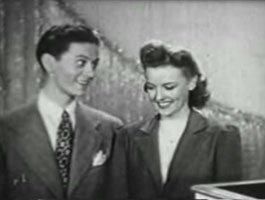 Claude Thornhill & His Orchestra are backing singing duet Martha Wayne & Buddy Stewart. The setting is a dance club. We watch the husband & wife duet Martha & Buddy go through a line to buy tickets, then saunter through a cafe area toward the edge of a dance floor, the whole while singing the title number Count Me In (1942).
Claude Thornhill & His Orchestra are backing singing duet Martha Wayne & Buddy Stewart. The setting is a dance club. We watch the husband & wife duet Martha & Buddy go through a line to buy tickets, then saunter through a cafe area toward the edge of a dance floor, the whole while singing the title number Count Me In (1942).
They take turns singing lines of the lyrics, Martha first: "If you're counting on a night when we can be alone together, count me in/ If your friends are coming over to kind of look me over, count me out..." The lyrics are lightweight, whimsical without quite being funny. It's a an average competent swing tune, & was a moderate hit for Claude Thornhill's orchestra, Martha & Buddy also singing it on the Columbia recording.
An ongoing joke throughout the soundie is that Martha & Buddy are so wrapped up in their song to one another that they don't realize they are blocking others from getting tickets & reaching the dancefloor. On one occasion the petite singers (even Buddy is small) are lifted up by a bigger patron & physically moved out of the way.
At the halfway point of the soundie we finally see the Claude Thornhill orchestra, until then heard but not seen. Claude is shown in a brief close-up doing a tinkly riff at his white piano in front of the band.
When Martha & Buddy are again singing, they're half-heartedly dancing, but definitely aren't dancers. They have considerable charm, if not a little too cutesy, & overall it's a nicely done soundie even if the tune is minor.
Martha Wayne & Buddy Stewart can also be seen in the Snader telescription Where Has My Little Dog Gone (1951).
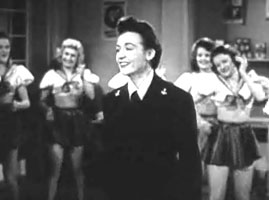 Evelyn Brooks & Mitzi's Lucky Girls do their patriotic turn in Dot Dot Dot Dash (1943). Set in a USO club, Mitzi's Lucky Girls are a dance troupe showing lots of leg, as soldiers are arrayed around the room at small tables.
Evelyn Brooks & Mitzi's Lucky Girls do their patriotic turn in Dot Dot Dot Dash (1943). Set in a USO club, Mitzi's Lucky Girls are a dance troupe showing lots of leg, as soldiers are arrayed around the room at small tables.
They're singing the titular novelty number so extremely badly one is tempted to suppose it was an intentional joke that these gals can't sing.
The lyrics identify their ring-around-the-rosies & cartwheelign choreography is "a victory dance." After about a minute of this nonsense, out strolls Evelyn Brooks dressed in a much more serious military dress uniform, probably because she really was part of an enlisted entertainment corp & the skimpy chorus girl outfits wouldn't be apropos of authentic service.
She has a good voice & the song is transformed into something almost tolerable: "There is something in the air/ You hear it everywhere/ It's sounding over here & over there/ Dot-dot-dot-dash, that stands for V/ Dot-dot-dot-dash, means victory..."
Evelyn finishes the lyrics then strides off stage, leaving the chunky clunky dancers to clod around the floor, but at least they're not singing any more. When they begin tapping, that's kind of cute. Evelyn returns for a short closing refrain. It's all kind of preciouis & very lame.
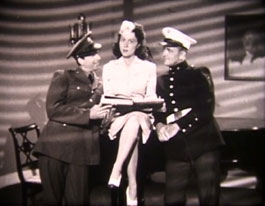 A rather putrid patriotic soundie in support of the war as a cheery upbeat sort of affair, My Great-Great Grandfather (1942) is another of those miniature films that may well have been produced with military/government funding.
A rather putrid patriotic soundie in support of the war as a cheery upbeat sort of affair, My Great-Great Grandfather (1942) is another of those miniature films that may well have been produced with military/government funding.
The star, Connie Haines, appeared in four soundies, plus some Snader telescriptions. She had sung for the Tommy Dorsey orchestra & was the regular featured singer on Abbott & Costello's radio series, easily transitioning into early television variety shows. As her husband was ace fighter pilot Colonel Robert DeHaven, she was perhaps more apropriate than average singing a patriotic ditty.
The little film opens on a bust of George Washington as we already hear Connie Haines singing: "The spirit of seventy-six/ Marching along through the years/ Farmers & bankers & clerks/ Ready to dish out the works/ When an enemy appears/ For we're still minute-men brave &am free/ Born to win it, men, with a grand old family tree."
The camera has swung left to show Connie in a WAC uniform, flanked by a couple scrawny actors in officers' dress uniforms, one army, one navy. Momentarily a gob & a jarhead join the line of characters, regular joes who squelch the initial feeling that the setting is supposed to be an officers' club.
Connie's seated on what must be a tall desk, with a photograph album open in her lap. This ties in to the next lyrics: "My great-great grandfather came to America/ Because in America a man was free/ He worked & fought for he was the son of America/ Fight with the hurricane, believe you me/ Well he had sons & they were the ones/ Who fought for July the fourth/ And their grandsons shouldered their guns/ Some for the south or the north/ And so it goes...."
Yeah, & so it goes, truly stink-a-roony. You'd think it couldn't get worse, but the instrumental break is a recitation of presidents' names to military horn & marching drum.
copyright © by Paghat the Ratgirl
|
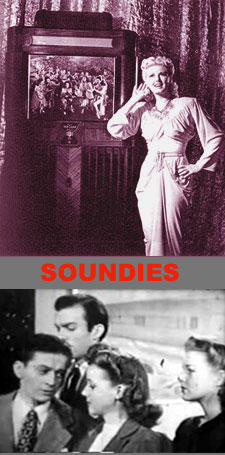

 He leaps up from bed, spry as you please, right into a wheelchair. One of the doctors pushing him through the French doors into a day room. Five nurses gather round him, flirting, hugging, showing no professional disposition toward nursing, so perhaps it isn't really a hospital but a bordello in which everyone is just playing hospital.
He leaps up from bed, spry as you please, right into a wheelchair. One of the doctors pushing him through the French doors into a day room. Five nurses gather round him, flirting, hugging, showing no professional disposition toward nursing, so perhaps it isn't really a hospital but a bordello in which everyone is just playing hospital.
 The band's leader, Dave Schooler, was noted for glamorous stage productions & musicals, & did USO shows during the war, so perhaps the all girl orchestra was part of some obscure USO troupe entertaining soldiers.
The band's leader, Dave Schooler, was noted for glamorous stage productions & musicals, & did USO shows during the war, so perhaps the all girl orchestra was part of some obscure USO troupe entertaining soldiers.


 After an introductory scene of warplanes, to a generic military marching tune, the Glamourettes stride long-legged down a staircase in costumes half showgirl & half airforce uniform, doing high kicks then lining up for some enfeebled French can-can kicks.
After an introductory scene of warplanes, to a generic military marching tune, the Glamourettes stride long-legged down a staircase in costumes half showgirl & half airforce uniform, doing high kicks then lining up for some enfeebled French can-can kicks.
 In the post war period Buddy sang bebop with the Gene Krupa band & the Charlie Barnet's orchestra, but an early death in 1950, still in his twenties, in a car accident, meant he was not around for all the bebop advances of the '50s.
In the post war period Buddy sang bebop with the Gene Krupa band & the Charlie Barnet's orchestra, but an early death in 1950, still in his twenties, in a car accident, meant he was not around for all the bebop advances of the '50s.

